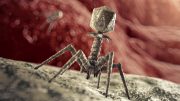
A new study led by the Stanford School of Medicine shows that the drug omalizumab can significantly reduce the risk of severe allergic reactions in children with food allergies by protecting against small, accidental exposures to allergens. The FDA-approved treatment, highlighted for its promising results in a multi-food allergic patient study, suggests a breakthrough in managing life-threatening food allergies, offering hope for safer daily living conditions for affected individuals.
A Stanford Medicine-led study discovered that a medication capable of attaching to antibodies responsible for allergies can safeguard children against severe reactions from unintentional consumption of allergy-triggering foods.
A new study led by scientists at Stanford School of Medicine has found that a drug can make life safer for children with food allergies by preventing dangerous allergic responses to small quantities of allergy-triggering foods.
The research was recently published in the New England Journal of Medicine. The findings suggest that regular use of the drug, omalizumab, could protect people from severe allergic responses, such as difficulty breathing, if they accidentally eat a small amount of a food they are allergic to.
“I’m excited that we have a promising new treatment for multifood allergic patients. This new approach showed really great responses for many of the foods that trigger their allergies,” said the study’s senior author, Sharon Chinthrajah, MD, associate professor of medicine and of pediatrics, and the acting director of the Sean N. Parker Center for Allergy and Asthma Research at Stanford Medicine.
“Patients impacted by food allergies face a daily threat of life-threatening reactions due to accidental exposures,” said the study’s lead author, Robert Wood, MD, professor of pediatrics at Johns Hopkins University School of Medicine. “The study showed that omalizumab can be a layer of protection against small, accidental exposures.”
Omalizumab, which the Food and Drug Administration originally approved to treat diseases such as allergic asthma and chronic hives, binds to and inactivates the antibodies that cause many kinds of allergic disease. Based on the data collected in the new study, the FDA approved omalizumab for reducing risk of allergic reactions to foods on Feb. 16.
All study participants were severely allergic to peanuts and at least two other foods. After four months of monthly or bimonthly omalizumab injections, two-thirds of the 118 participants receiving the drug safely ate small amounts of their allergy-triggering foods. Notably, 38.4% of the study participants were younger than 6 years, an age group at high risk from accidental ingestions of allergy-triggering foods.
Allergies are common
Food allergies affect about 8% of children and 10% of adults in the United States. People with severe allergies are advised to fully avoid foods containing their allergy triggers, but common allergens such as peanuts, milk, eggs, and wheat can be hidden in so many places that everyday activities such as attending parties and eating in restaurants can be challenging.
“Food allergies have significant social and psychological impacts, including the threat of allergic reactions upon accidental exposures, some of which can be life-threatening,” Chinthrajah said. Families also face economic impacts from purchasing more expensive foods to avoid allergens, she added.
In the best available treatment for food allergies, called oral immunotherapy, patients ingest tiny, gradually increasing doses of allergy-triggering foods under a doctor’s supervision to build tolerance. But oral immunotherapy itself can trigger allergic responses, desensitization to allergens can take months or years, and the process is especially lengthy for people with several food allergies, as they are usually treated for one allergy at a time. Once they are desensitized to an allergen, patients also must continue to eat the food regularly to maintain their tolerance to it — but people often dislike foods they were long required to avoid.
“There is a real need for treatment that goes beyond vigilance and offers choices for our food-allergic patients,” Chinthrajah said.
Omalizumab is an injected antibody that binds and deactivates all types of immunoglobin E, or IgE, the allergy-causing molecule in the blood and on the body’s immune cells. So far, omalizumab appears able to provide relief from multiple food allergens at once.
“We think it should have the same impact regardless of what food it is,” Chinthrajah said.
Injections stave off severe reactions
The study included 177 children with at least three food allergies each, of whom 38% were 1 to 5 years old, 37% were 6 to 11 years old, and 24% were 12 or older. Participants’ severe food allergies were verified by skin-prick testing and food challenges; they reacted to less than 100 milligrams of peanut protein and less than 300 milligrams of each other food.
Two-thirds of the participants were randomly assigned to receive omalizumab injections, and one-third received an injected placebo; the injections took place over 16 weeks. Medication doses were set based on each participant’s body weight and IgE levels, with injections given once every two or four weeks, depending on the dose needed. The participants were re-tested between weeks 16 and 20 to see how much of each allergy-triggering food they could safely tolerate.
Upon re-testing, 79 patients (66.9%) who had taken omalizumab could tolerate at least 600 mg of peanut protein, the amount in two or three peanuts, compared with only four patients (6.8%) who had the placebo. Similar proportions of patients showed improvement in their reactions to the other foods in the study.
About 80% of patients taking omalizumab were able to consume small amounts of at least one allergy-triggering food without inducing an allergenic reaction, 69% of patients could consume small amounts of two allergenic foods and 47% could eat small amounts of all three allergenic foods.
Omalizumab was safe and did not cause side effects, other than some instances of minor reactions at the site of injection. This study marks the first time its safety has been assessed in children as young as 1.
More questions
More research is needed to further understand how omalizumab could help people with food allergies, the researchers said.
“We have a lot of unanswered questions: How long do patients need to take this drug? Have we permanently changed the immune system? What factors predict which people will have the strongest response?” Chinthrajah said. “We don’t know yet.”
The team is planning studies to answer these questions and others, such as finding what type of monitoring would be needed to determine when a patient gains meaningful tolerance to an allergy-triggering food.
Many patients who have food allergies also experience other allergic conditions treated by omalizumab, Chinthrajah noted, such as asthma, allergic rhinitis (hay fever and allergies to environmental triggers such as mold, dogs or cats, or dust mites) or eczema. “One drug that could improve all of their allergic conditions is exactly what we’re hoping for,” she said.
The drug could be especially helpful for young children with severe food allergies, she added, because they tend to put things in their mouths and may not understand the dangers their allergies pose, she added.
The drug could also make it safer for community physicians to treat food allergy patients, since it cannot trigger dangerous allergic reactions, as oral immunotherapy sometimes does. “This is something that our food allergy community has been waiting a long time for,” Chinthrajah said. “It’s an easy drug regimen to implement in a medical practice, and many allergists are already using this for other allergic conditions.”
Reference: “Omalizumab for the Treatment of Multiple Food Allergies” by Robert A. Wood, Alkis Togias, Scott H. Sicherer, Wayne G. Shreffler, Edwin H. Kim, Stacie M. Jones, Donald Y.M. Leung, Brian P. Vickery, J. Andrew Bird, Jonathan M. Spergel, Ahmar Iqbal, Julie Olsson, Monica Ligueros-Saylan, Alkaz Uddin, Agustin Calatroni, Charmaine Marquis Huckabee, Nicole H. Rogers, Nancy Yovetich, Jennifer Dantzer, Kim Mudd, Julie Wang, Marion Groetch, David Pyle, Corinne A. Keet, Michael Kulis, Sayantani B. Sindher, Andrew Long, Amy M. Scurlock, Bruce J. Lanser, Tricia Lee, Christopher Parrish, Terri Brown-Whitehorn, Amanda K. Rudman Spergel, Maria Veri, Sanaz Daneshfar Hamrah, Erica Brittain, Julian Poyser, Lisa M. Wheatley and R. Sharon Chinthrajah, 24 February 2024, New England Journal of Medicine.
DOI: 10.1056/NEJMoa2312382
The research team included scientists from the Johns Hopkins University School of Medicine, the National Institutes of Allergy and Infectious Diseases, the Icahn School of Medicine at Mount Sinai, Massachusetts General Hospital, the University of North Carolina School of Medicine, the University of Arkansas for Medical Sciences and Arkansas Children’s Hospital, Emory University School of Medicine and Children’s Healthcare of Atlanta, University of Texas Southwestern Medical Center, Perelman School of Medicine at the University of Pennsylvania, Genentech/Roche, Novartis Pharmaceuticals Corporation, and Rho, Inc.
The research was funded by the National Institute of Allergy and Infectious Diseases and the National Center for Advancing Translational Sciences, both part of the National Institutes of Health (grant numbers UM2AI130836, UM1AI130838, UL1TR003098, UM1TR004408, UM1AI130570, UM1AI130839, UM1AI130936, UM1TR004406, UL1TR002535, UM1TR004399, UL1TR001878, UM1AI130781, UL1TR002378 and UL1TR003107), and the Claudia and Steve Stange Family Fund. Genentech/Novartis provided the investigational product and monetary support to Johns Hopkins University and collaborated on the study design.









Be the first to comment on "Stanford Study: Breakthrough Treatment Protects Kids From Deadly Food Allergies"